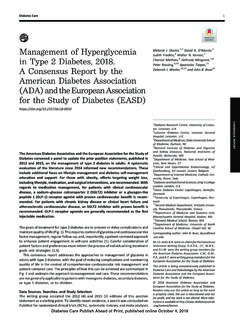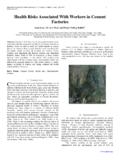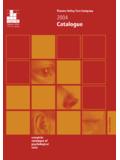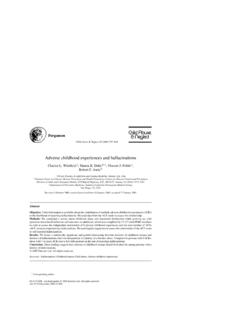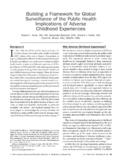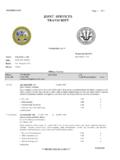Transcription of Global Malaria Programme - WHO
1 Gl o b a l M a la ria Pro gra m m e Test procedures for insecticide resistance monitoring in Malaria vector mosquitoes Second edition For further information please contact: Global Malaria Programme World Health Organization 20 Avenue Appia CH-1211 Geneva 27. Switzerland Email: Test procedures for insecticide resistance monitoring in Malaria vector mosquitoes Second edition This document was updated in June 2018. Please consult the website for any content updates ( ). WHO Library Cataloguing-in-Publication Data Test procedures for insecticide resistance monitoring in Malaria vector mosquitoes 2nd ed. Resistance. - prevention and control. Control. Health Organization. ISBN 978 92 4 151157 5 (NLM classification: WA 240). World Health Organization 2016. All rights reserved. Publications of the World Health Organization are available on the WHO website ( ) or can be purchased from WHO Press, World Health Organization, 20 Avenue Appia, 1211 Geneva 27, Switzerland (tel.)
2 : +41 22 791. 3264; fax: +41 22 791 4857; email: Requests for permission to reproduce or translate WHO publications whether for sale or for non-commercial distribution . should be addressed to WHO Press through the WHO website ( ). The designations employed and the presentation of the material in this publication do not imply the expression of any opinion whatsoever on the part of the World Health Organization concerning the legal status of any country, territory, city or area or of its authorities, or concerning the delimitation of its frontiers or boundaries. Dotted and dashed lines on maps represent approximate border lines for which there may not yet be full agreement. The mention of specific companies or of certain manufacturers' products does not imply that they are endorsed or recommended by the World Health Organization in preference to others of a similar nature that are not mentioned.
3 Errors and omissions excepted, the names of proprietary products are distinguished by initial capital letters. All reasonable precautions have been taken by the World Health Organization to verify the information contained in this publication. However, the published material is being distributed without warranty of any kind, either expressed or implied. The responsibility for the interpretation and use of the material lies with the reader. In no event shall the World Health Organization be liable for damages arising from its use. Table of contents Acknowledgements 1. Abbreviations 2. Glossary 3. 1. Introduction 6. 2. Evolution of the WHO insecticide susceptibility test: background to current revision 10. 3. WHO susceptibility test for adult mosquitoes 12. Susceptibility tests with discriminating concentration 12. Susceptibility tests for determining intensity of resistance 13.
4 Sampling protocols 20. Selection of test specimens 20. Spatial distribution and frequency of susceptibility testing 22. Sample size 23. Species identification 24. Test conditions and protocols 24. Number of test mosquitoes 25. Ambient conditions 25. Number of uses of the impregnated papers 25. Mortality and adjustment calculations 25. Interpretation of results 26. Susceptibility tests with discriminating concentration 26. Susceptibility tests with 5 and 10 discriminating concentrations 27. Equipment and supplies 28. Procurement 28. Composition of the WHO test kit 28. Insecticide- and synergist-impregnated papers 29. 4. Further field investigations: synergist-insecticide bioassays as a proxy for metabolic resistance mechanisms 30. Use of synergists in insecticide susceptibility tests 30. Recording and reporting results from synergist-insecticide bioassay 32.
5 Measuring mortality 32. Comparing samples exposed to synergist with those not exposed 33. Interpretation of synergist-insecticide test results 33. Equipment and supplies 34. 5. The CDC bottle bioassay for adult mosquitoes 35. Bottle bioassay with discriminating concentrations and times 35. Bottle bioassay with intensity concentrations 35. Advantages and disadvantages of bottle bioassay 35. 6. Further laboratory investigations: identification of resistance mechanisms 38. 7. Data management and use 39. Management and sharing of data 39. Use of data in decision-making 39. 8. Additional recommendations 41. References 42. Annexes 45. Annex 1. Form for recording information on mosquito collections and test conditions 44. Annex 2. Form for recording results of susceptibility tests using discriminating, 5 and 10 concentrations 45.
6 Annex 3. Form for recording results from synergist-insecticide assays 46. Annex 4. Discriminating concentrations and exposure time of insecticides commonly used for Aedes mosquitoes 48. iv Acknowledgements The following individuals contributed to the development of these test procedures and the Global Malaria Programme of the World Health Organization would like to acknowledge their valuable contribution: Birkinesh Ameneshewa, Bill Brogdon, Basil Brooke, Fabrice Chandre, Adanan Che Rus, Maureen Coetzee, Martin Donnelly, Josiane Etang, Christen Fornadel, Mary Anne Groepe, Pierre Guillet, Melinda Hadi, Jeffrey Hii, Zairi Jaal, Tessa Knox, Jan Kolaczinski, Abraham Mnzava, Martha Quinones, Hilary Ranson, Mark Rowland, Emmanuel Temu and Rajpal Yadav. Updates Minor revisions were made to this edition in June 2018, mainly to: adapt Figure to provide a more comprehensive overview; align with statistics provided in the latest World Malaria report; and, include information and citations for other publications released recently.
7 Test procedures for insecticide resistance monitoring in Malaria vector mosquitoes Second edition 1. Abbreviations AI active ingredient CDC US Centers for Disease Control and Prevention DDT dichlorodiphenyltrichloroethane ELISA enzyme-linked immunosorbent assay GMP WHO Global Malaria Programme GPIRM Global plan for insecticide resistance management in Malaria vectors IRS indoor residual spraying ITN insecticide-treated mosquito net kdr knockdown resistance LLIN long-lasting insecticidal net NMCP national Malaria control Programme PBO piperonyl butoxide PCR polymerase chain reaction rdl resistance to dieldrin WHO World Health Organization WHOPES World Health Organization Pesticide Evaluation Scheme 2. Glossary Ace-1 A target-site resistance gene for carbamate and organophosphate insecticides conferring insensitive acetylcholinesterase.
8 The resistance is caused by a single mutation, G119S, of the Ace-1 gene. cross-resistance Resistance to one insecticide by a mechanism that also confers resistance to insecticides of another class, even where the insect population or strain has not been selected by exposure to the latter. F1 progeny Generally means first generation offspring , but in this context refers to the use of adults raised from the eggs of wild-caught female mosquitoes to obtain an age- standardized sample of the wild population for use in bioassay tests for resistance. insecticide Application of two or more insecticides with unrelated combination modes of actions within a house or a building ( one insecticide class on the wall surfaces, and another class on nets used in the same household). Application of insecticide combinations differs from the use of insecticide mixtures in that, with a combination, an insect is likely but not guaranteed to come into contact with both insecticides.
9 Insecticide Concentration of an insecticide that, in a standard period discriminating of exposure, is used to discriminate the proportions of (or diagnostic) susceptible and resistant phenotypes in a sample of a concentration mosquito population. It is expressed as a percentage of an active ingredient per unit volume of a carrier oil that is applied in a fixed amount per unit area on the test paper. Note: A discriminating concentration combines a fixed exposure time and the amount of insecticide on a test paper, the uptake of which depends on the time of actual tarsal contacts. Test procedures for insecticide resistance monitoring in Malaria vector mosquitoes insecticide A fixed dose of an insecticide ingredient dissolved in a discriminating (or solvent that is topically applied on the mosquito body; used diagnostic) dose for to discriminate the proportions of susceptible and resistant resistance phenotypes in a sample of a mosquito population.
10 Note: Where the genetic factor for resistance is either dominant or recessive, only one discriminating dose operates. Where the factor is semidominant, two such doses may operate: a lower dose that kills susceptible mosquitoes only, and an upper dose that kills both susceptible and heterozygous (but not homozygous) resistant mosquitoes. insecticide mixture An insecticide product comprising either two or more co- formulated active ingredients (AIs) or a product prepared as a tank mixture using two or more AIs so that, when applied, the mosquito will come into contact with both or all of them simultaneously. For resistance management, a mixture usually includes AIs of different classes. Second edition 3. insecticide mosaic A method for mitigating resistance, whereby insecticides with different modes of action are applied in separate parts of a surface area under coverage (usually in a grid pattern), so that parts of the mosquito populations are likely to be exposed to one insecticide and others to another insecticide of a different class.










